Introduction
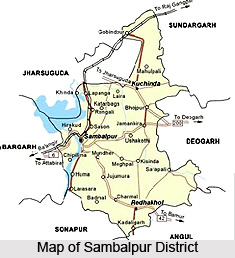 Sambalpur District is the westernmost district of Orissa and it had been named after the headquarters town, Sambalpur. According to historical records, the town derived its name from the presiding goddess Samalai, whose stone image was discovered by Balaram Dev, the first Chauhan king of Sambalpur.
Sambalpur District is the westernmost district of Orissa and it had been named after the headquarters town, Sambalpur. According to historical records, the town derived its name from the presiding goddess Samalai, whose stone image was discovered by Balaram Dev, the first Chauhan king of Sambalpur.
Location of Sambalpur District
Sambalpur District lies between 20 degree 40 minutes north and 22 degree 11 minutes north latitude and 82 degree 39 minutes east and 85 degree 15 minutes east longitude with a total area of 6,702 sq kms. The district is surrounded by Deogarh District in the east, Bargarh District and Jharsuguda district in the west, Sundargarh District in the north and Subarnapur District and Angul district in the south.
History of Sambalpur
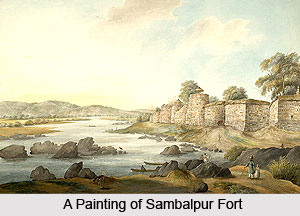 The history of Sambalpur district as depicted by the eminent historians is full of events including Indian Freedom Struggle representing the different section of society. Since Sambalpur is one of the ancient districts of Orissa, which survived even in the prehistoric age, much of the historical records about the origin and the existence of Sambalpur in the political scenario of Orissa are still in obscurity.
The history of Sambalpur district as depicted by the eminent historians is full of events including Indian Freedom Struggle representing the different section of society. Since Sambalpur is one of the ancient districts of Orissa, which survived even in the prehistoric age, much of the historical records about the origin and the existence of Sambalpur in the political scenario of Orissa are still in obscurity.
The historical details of Sambalpur are recorded from the period, when Samudragupta defeated king Mahendra of Kosala, the kingdom that included Sambalpur in 4th century. During the 5th and 6th century B.C the district of Sambalpur came under the jurisdiction of the Sarabhapuriya. However the Sarbhapuriyas were not destined to retain their sovereignty for long and the Panduvansi king Trivaradeva ousted the Sarabhapuriya and became the sole authority of Sambalpur district. Towards the close of 9th century king Janmeyjaya I Mahabhavagupta extended his empire, which encompassed the modern districts of Sambalpur and Bolangir. Hence forward, his dynasty came to be known as the Somavansi dynasty. During the final years of the Somavansi dynasty, the Kalucharis of Rajputana dominated the pages of the history of Sambalpur district. However in a blood-spattered atrocious battle the Gandas defeated the Somavansis and occupied Sambalpur.
As far as the history of Sambalpur is concerned a number of indigenous and the foreign kings have colonized the district. During the middle of the 14th century Ramai Dev placed the foundation of the Chauhan rule in Western Orissa and he was at the helm of administration of the entire western Orissa including the present district of Sambalpur. But the Chauhan kings had to yield before the Maratha ascendancy and as is revealed by the British history of Sambalpur that during the British supremacy, the Marathas were the existing native kings in Orissa and when the British received the grant of Diwani of Orissa, they are at the continuous strife with the Marathas. The British occupied Sambalpur on 2nd January 1804 and sanctioned as the British administrative unit in 1817. The history of Sambalpur in the subsequent years witnessed the movements of the Kandhas and Binjhal Zamindars against the British and their puppet ruler in Sambalpur was Rani Mohan Kumari.
During the British supremacy in Orissa, Sambalpur activated as the nodal agency where the spirit of nationalism imbued the inhabitants to participate in the national struggle. The modern history of Sambalpur is marked with the mass involvement in the Indian struggle for independence headed by Surendra Sai.
History of Sambalpur states that in the post independence period the former princely district of Sambalpur was subdivided into four separate administrative districts namely Sambalpur, Bargarh, Jharsuguda and Deogarh prior to the notification of Revenue & Excise Department Resolution No 14993/R Dtd 31.03.93 and Resolution No 56413/R Dtd 22.12.93.Bargarh district comprising Barhgarh and Padampur Subdivision started functioning with effect from 1.4.1993.Jharsuguda and Deogarh District started functioning w.e.f. 1.1.94.
Geography of Sambalpur District
Sambalpur District has three distinctive physiographic units such as, hilly terrain of Bamra and Kuchinda in the north, plateau and ridges of Rairakhol in the south-east and valley and plains of Sambalpur sub-division in the south east. This district experiences extreme type of climate with hot and dry summer followed by humid monsoon and severely cold winter. The hot season commences from 1st week of March and lasts till the second half of June. Sambalpur district experiences 66 rainy days and 153 centimeters rainfall on an average per annum. Most of the rainfall is confined to the months from June to October visited by south west monsoon. Mercury increases up to 47 degree Celsius during May with intolerable heat wave and falls as low as 11 degree Celsius during December with extreme cold.
 The rainfall is highly uneven and irregular. After rainy season the humidity gradually decreases and the weather becomes dry towards the winter. Sambalpur District forms a part of the Mahanadi River basin. The Mahanadi, the longest river of the state, enters into the district in the north western border, where the famous Hirakud Multipurpose Dam Project is built. Other important rivers of the district are the Maltijor, the Harrad, the Kulsara, the Bheden, and the Phuljharan. The district has a total forest area of 3986.27 sq kms which is around 59.46 percent of the total area of the district. Total land under cultivation in the district is 173540 hectares. Most of the villages of the district are inaccessible during the rainy season. Sambalpur district forms a part of North-West upland of Orissa, which is rolling and multiplying the ground slopes from a height of 776 feet to a height of 460 feet. The district has regur soil.
The rainfall is highly uneven and irregular. After rainy season the humidity gradually decreases and the weather becomes dry towards the winter. Sambalpur District forms a part of the Mahanadi River basin. The Mahanadi, the longest river of the state, enters into the district in the north western border, where the famous Hirakud Multipurpose Dam Project is built. Other important rivers of the district are the Maltijor, the Harrad, the Kulsara, the Bheden, and the Phuljharan. The district has a total forest area of 3986.27 sq kms which is around 59.46 percent of the total area of the district. Total land under cultivation in the district is 173540 hectares. Most of the villages of the district are inaccessible during the rainy season. Sambalpur district forms a part of North-West upland of Orissa, which is rolling and multiplying the ground slopes from a height of 776 feet to a height of 460 feet. The district has regur soil.
Culture of Sambalpur District
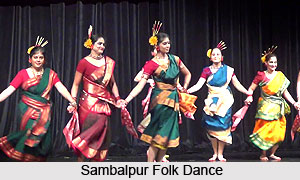 Culture is an inseparable part of the identity of the people of Sambalpur district. The language, dance, songs and festivals everything is intensely linked with the cultural heritage of this district in Orissa. Language is a distinctive feature of the people belonging here. There are two language group, Mundari language group and the Dravidian language group. Dance forms of this district are mostly connected with a function or the worship of a deity. Music is also an indispensable part of the culture of the people here. Sital sashti, nuakhai and puajiuntia are among the most popular festivals celebrated here. Sambalpuri sarees have gained nationwide recognition for their fine texture and beauty.
Culture is an inseparable part of the identity of the people of Sambalpur district. The language, dance, songs and festivals everything is intensely linked with the cultural heritage of this district in Orissa. Language is a distinctive feature of the people belonging here. There are two language group, Mundari language group and the Dravidian language group. Dance forms of this district are mostly connected with a function or the worship of a deity. Music is also an indispensable part of the culture of the people here. Sital sashti, nuakhai and puajiuntia are among the most popular festivals celebrated here. Sambalpuri sarees have gained nationwide recognition for their fine texture and beauty.
People of Sambalpur district mostly enjoy colourful folk dances. The community dances are connected with the worship of a deity. Dhalkhai dance is performed by young girls of Binjhals, Soura and Mirdha tribes during Dussehra, Bhaijiuntia and other festive occasions. The young girls stand in a line or in a semicircular pattern singing songs known as Dalkhai songs. Karma is the most colourful dance of Sambalpur district. It is a tribal dance in honour of "Karam Sani", the deity who grants children. In the beginning the dancers enter the dancing arena in two rows. The drummers and the singers accompany with rhythmic steps. Humo and Bauli are the two playful dances performed by young and unmarried girls on special occasions. The stepping and movements of the dance are very slow. Koisabadi dance is prevalent among the Gond and the Bhuyan tribes. Male dancers take part, holding a two feet long stick. The songs are mainly based on the immortal love story of Radha and Lord Krishna.
The Folk instruments which are in vogue in Sambalpur district region are Dhole, Madal, Nishan, Tasa, Pakhoj, Bansi, Bir-Kahali, Gini, Ektara, Muhuri, Ghulgula, Ghunguru, Jhanj etc. Dhole is an age old instrument of Folk Music. The Dhole of Sambalpur is to some extent different in its making and use. Made from the trunk of a tree, the sides of the Dhole are of same size. Sambalpur dhole can be used for any type of Sambalpuri Folk Song. The Sambalpuri Madal is dissimilar from that of all other parts of India. The Madal is made out of fired clay and is shaped like a cylinder. Madal is a drum which is used in slower rhythms. Most of the dance less songs is accomplished with the Madal. Nishan is made out of iron sheets. The sound emitted by the Nishan is heart-throbbing. This is mostly used in worship of Goddess Kali or Goddess Durga and in the battle field.
Festivals of Sambalpur help to illustrate the vibrant culture of the place. Sital Sasthi is the Marriage Ceremony of Lord Shiva with Parvati. The festival is observed in the month of June with pomp and ceremony at Sambalpur district and is extended for a week. Pilgrims from the neighbouring districts and States of Madhya Pradesh and Bihar also take part in the festival. Lakhs of people gather together in this week long festival. Nuakhai is the most important social festival of this district. Generally it takes place during the month of August and September. The first grains of the paddy crop, cooked into various dishes are offered to the deities. Thereafter the eldest member of the family distributes new rice to the junior members of the family. It is a community festival celebrated by every Hindu family. Bhaijiuntia festival is celebrated on the Mahastami Day of Durga Puja. It is a total fasting undertaken by women for the whole day and night to seek Goddess Durga`s blessing for the long life of their brothers. The Puajiuntia festival is observed by mothers to invoke the grace of Lord Dutibahana for the long life and prosperity of their sons. Others religious festivals which are observed include Shiva Ratri, Dola Yatra, Durga Puja, Janmastami, Diwali, Ganesh Puja and Saraswati Puja.
Festivals, music and dance contribute to the richness of the culture of Sambalpur district. They reflect the age old tradition and the glorious past of the people of Sambalpur district.
Festivals in Sambalpur District
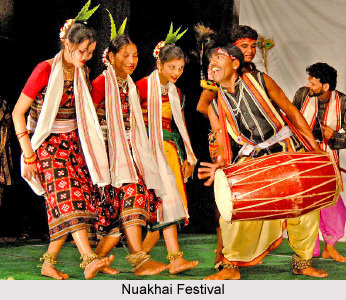 Festivals in Sambalpur district, Odisha, are celebrated with great vigour and enthusiasm. These are mostly observed in the honour of specific deities and allure a large number of devotees, even from far off places. Fasting is a common practice in the festivals of this district. The celebrations are sometimes accompanied by grand fairs which add to the spirit of the festivals. Sambalpur district host a number of festivals belonging to different communities which also act as a catalyst of communal harmony and spreads fun and gaiety among the people.
Festivals in Sambalpur district, Odisha, are celebrated with great vigour and enthusiasm. These are mostly observed in the honour of specific deities and allure a large number of devotees, even from far off places. Fasting is a common practice in the festivals of this district. The celebrations are sometimes accompanied by grand fairs which add to the spirit of the festivals. Sambalpur district host a number of festivals belonging to different communities which also act as a catalyst of communal harmony and spreads fun and gaiety among the people.
Sital Sasthi Festival
Sital Sasthi is celebrated to commemorate the marriage ceremony of Lord Shiva with Parvati. It is a week long festival, observed in the month of June and is characterised by great pomp and glory. The festival invites a large number of devotees from neighbouring districts and states who participate in the festival with great religious vigour.
Nuakhai Festival
Nuakhai is another significant social festival of the district which is observed in the months of August and September. The preparations for the festival begin fifteen days prior to the occasion. As offerings to the deities, the first grains of paddy crop are cooked into various dishes. The new rice is then distributed by the eldest member of the family to others. The houses are cleaned and beautifully decorated. People greet each other and the spirit of the festival can be felt throughout the Hindu community irrespective of economic strata.
Bhai Juntia Festival
On the Mahastami day of Durga Puja, Bhai Juntia festival is celebrated with great devotion. This festival is common mostly in the regions of western Odisha. On this occasion, girls and women observe a whole day fast for seeking the blessings of Goddess Durga for long life of their brothers. `Bhai` is the Oriya term for brother.
Puajiuntia Festival
Puajiuntia festival is also celebrated by the women of the district. On this occasion, fasting is observed by the mothers for the prosperity and long life of their sons. Their fast is believed to invoke the grace of Lord Dutibahana for the same purpose.
Other Festivals of Sambalpur District
Apart from these, other Hindu festivals celebrated in the district involve Saraswati Puja, Ganesh Puja, Diwali, Janmashtami, Durga Puja, Dola Yatra and many more. During the festival of Shivaratri, a grand fair is organized at Huma which invites a plethora of devotees. Makara Jatra is another huge fair held at Themra of Sambalpur district. Ratha Yatra is a significant festival which is celebrated in almost all parts of the district. Sikhs residing in the district celebrate Guru Nanak Jayanti as one of their main festivals. Among the Muslim community, Id ul Zuha, Eid Ul Fitr and Muharram are the important festivals observed.
Tribal Dances of Sambalpur District
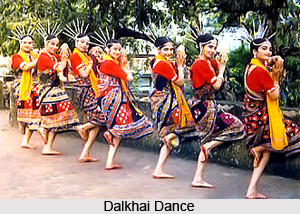 Tribal dances of Sambalpur district are one of the major contributors in constituting the vibrant cultural heritage of the district. Famed as the land of tribal dances, the district hosts several festivals where these exquisite dances form the major attractions. Most of the tribal dances of Sambalpur district are associated with religious beliefs, tribal deities and different occasions. These colourful dances are characterised by enchanting dance steps and enthusiastic execution. A variety of musical instruments such as Tasha, Nishan, Madal, Dhole etc are used as an accompaniment in these dances which greatly augment their essence. These wondrous tribal dances also invite numerous tourists from far off regions to witness this unique part of the district culture.
Tribal dances of Sambalpur district are one of the major contributors in constituting the vibrant cultural heritage of the district. Famed as the land of tribal dances, the district hosts several festivals where these exquisite dances form the major attractions. Most of the tribal dances of Sambalpur district are associated with religious beliefs, tribal deities and different occasions. These colourful dances are characterised by enchanting dance steps and enthusiastic execution. A variety of musical instruments such as Tasha, Nishan, Madal, Dhole etc are used as an accompaniment in these dances which greatly augment their essence. These wondrous tribal dances also invite numerous tourists from far off regions to witness this unique part of the district culture.
Dalkhai Dance
Dalkhai dance is performed by the young girls of Mirdha, Soura and Binjhal tribes during the festivals like Bhaijuntia, Dussehra and others. Dalkhai songs are sung and the girls dance in a group making linear or semicircular pattern.
Humo and Bauli Dance
This is a combination of two playful dances performed by un-married and young girls in groups during special occasions. The dance is characterized by slow steps and movements.
Karma Dance
Karma dance is one of the most celebrated dances of the district and is a colourful one. This tribal dance is performed in the honour of Karam Sain, a deity who is believed to grant children as per the tribal beliefs. The performers enter the stage in two rows. The rhythmic steps are accompanied by songs and drum beats.
Koisabadi Dance
Koisabadi dance is widely performed by the dancers of Bhuyan and Gond tribes. Usually male dancers participate in this dance and perform with two feet long sticks. The songs of this dance are mainly based on the eternal love stories of Radha and Krishna.
Eminent Personalities of Sambalpur District
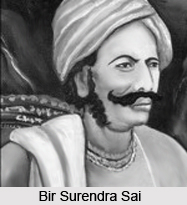 Eminent personalities of Sambalpur district, Odisha, have contributed much in the pride and glory of the district by rendering it prominence in various fields. Since ages, the district has been blessed with people whose works of literature, journalism, politics and humanitarian activities have played a vital role in the betterment of the social and cultural life of the people belonging to the district. Some of them have also actively participated in the freedom movement of India and have marked their contribution in disposing off the British domination on India. Their role in the society of is much revered and their works are still cherished by the people all around the nation. Their exceptional involvement in evoking a positive change in the society has earned admirable eminence to their names which has lasted even beyond their lives.
Eminent personalities of Sambalpur district, Odisha, have contributed much in the pride and glory of the district by rendering it prominence in various fields. Since ages, the district has been blessed with people whose works of literature, journalism, politics and humanitarian activities have played a vital role in the betterment of the social and cultural life of the people belonging to the district. Some of them have also actively participated in the freedom movement of India and have marked their contribution in disposing off the British domination on India. Their role in the society of is much revered and their works are still cherished by the people all around the nation. Their exceptional involvement in evoking a positive change in the society has earned admirable eminence to their names which has lasted even beyond their lives.
Bir Surendra Sai
Bir Surendra Sai, was born to a royal family in Badgaon village on 23rd January, 1809 and rose to the throne of Sambalpur in 1827. He was known as a warrior who fought against the British rule by leading a revolution with a huge number of protestors. He is also famed as `Shivaji of Odisha` for exhibiting a great devotion and patriotism for his motherland.
Gangadhar Meher
Gangadhar Meher is a renowned name in the Oriya literature who is greatly admired for his poems. He was born on 9th August 1962 in at Barpali region of undivided Sambalpur district. His poetries encompass a number of genres including devotional, lyrical, ethical, patriotic, and reformative and many others.
 Bhima Bhoi
Bhima Bhoi
Bhima Bhoi, was one of the celebrated poets of the district. Born in 1850, he was blind by birth. He was also a religious person. He developed his poetic skills and religious knowledge through the preaching of his guru "Mahima Mahaprabhu". He is the author of famous books like Bhajanamal, Ashtaka Bihari Gita, Sruti Nisedha Gita and Stuti Chintamani.
Satya Narayan Bohidar
Satya Narayan Bohidar was famed as the pioneer of Sambalpuri language and grammar. Born on 1st August, 1913 at Sonepur he had authored a number of literary translations and biographies.
Swapneswar Das
Swapneswar Das was another renowned poet and a well known journalist. He was born on 25th January 1866 in Rohinia village and started his career as a grammarian and translator. Veda Kalpadruma, a literary masterpiece, was composed by him, which is categorized into 75 volumes. He was also awarded with `Vidyalankar` honour.
Gokulanand Panda
Being an eminent poet, Gokulanand Panda had a great contribution in Indian literature. Hrudaya Lahari is one of his best compositions, which holds a collection of poetries dealing with life and experiences.
Sunil Mishra
Sunil Mishra is a prominent name in the fields of drama and journalism. `Jana Samikshya` which is a magazine on humour was founded by him. This playwright had composed a number of dramas among which the popular ones include Akbar Ray, Nursingha Nath and Manikya Munda.
Braja Mohan Panda
Born on 5th June, 1890, Braja Mohan Panda was a well known social worker, agriculturist, political activist, academician and litterateur. He played a vital role in the establishment of the oldest college of western Odisha, Larambha College. He had also been involved in the publishing of literary works of many luminaries.

Siba Prasad Das
The name of Siba Prasad Das is associated with the writings of history and children`s literature. Apart from this, he had also authored several books on environment and sports. He was the founder of a printing press in Sambalpur town, known as `Biswa Bharati` which owns an acclamation for its transparency in publishing industry. Born on 29th September, 1901 he is also the famous writer of the rare history of Sambalpur Atitara Odisha and Sambapur Itihas.
Nrusingha Guru
Nrusingha Guru, popular as `Gandhi of Western Odisha`, was a famous freedom fighter who actively took part in the freedom struggle of India. He was born in 1901 and was a journalist by profession. For more than two decades, he had worked for the news paper "Samaj".
Other Eminent Personalities of Sambalpur
Other eminent personalities of Sambalpur are Chandra Sekhar Behera, Jadunath Supakar, Sradhakar Supakar, Kasinath Singh, Isaac Santra, Biswaksen Mishra, Balunkeswar Mishra, Janardan Pujari and Laxminarayan Mishra.
Tourism in Sambalpur District
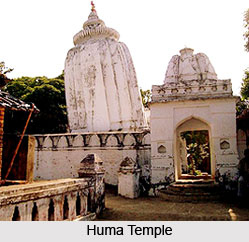 The prehistoric district of Sambalpur serves as the gateway to the enigmatic and bewitching beauty of western zone of Orissa, abounding in lush green forests, colorful wild-life, exquisite array of hills, waterfalls of streaming pearls, rich tribal life and culture, folk songs and dances and a variety of monuments. This diversified beauty encourages the tourism industry to flourish in Sambalpur. Sambalpur is endowed with much natural splendor unspoiled by modern Tourism. The fascinating charm abounds the district, promote the growth of tourism industry in Sambalpur centering several places in the pockets of Sambalpur.
The prehistoric district of Sambalpur serves as the gateway to the enigmatic and bewitching beauty of western zone of Orissa, abounding in lush green forests, colorful wild-life, exquisite array of hills, waterfalls of streaming pearls, rich tribal life and culture, folk songs and dances and a variety of monuments. This diversified beauty encourages the tourism industry to flourish in Sambalpur. Sambalpur is endowed with much natural splendor unspoiled by modern Tourism. The fascinating charm abounds the district, promote the growth of tourism industry in Sambalpur centering several places in the pockets of Sambalpur.
The prosperity of the tourism industry in Sambalpur is mainly centered on the longest dam of the world, Hirakund standing in its isolated magnificence across the great river Mahanadi. The significant interest about the dam is the structure and the water network it has formed to drain about 1,33,090 Sq.Km of area. The mighty Hirakund dam, with its fascinating charm composed by the fantastic expanse of water from the top of the revolving minaret called Gandhi Minar is the key feature, which entice the tourists.
Stationed in the extreme nook of the Hirakund Reservoir, Castle Island, the natural wonder is a pillar in the tourism industry of Sambalpur. The island is nothing but a sub-merged hill and before the construction of Hirakund Dam, was a developed village. The specialty of the island is the inhabitants, which comprise only the cattle population. Being denied of the natural domestic environment and spending whole of their life on the hill filled up with dense forest, their shape and size are quite bigger in comparison to the normal cattle. Apart from this, the exquisite view of the surrounding area is no less alluring to the tourist for which it is considered as one of the important center in the tourism industry of Sambalpur.
The leaning temple of lord Shiva, popularly known as Huma is one of the important center, which is famous in the tourism of Sambalpur as an important site of religious interest. Moreover a mythological story about the temple strengthens the religious interest of the temple. As the common belief runs the worship of Siva had been initiated by a milkman (Gauda), who everyday crossed the Mahanadi to a place on the bank where the underlying rock cropped out. He daily offered milk to that rock, which was at once drunk up by the rock, and this miraculous circumstance led to enquiries, and finally the rock was believed to be the personification of Lord Shiva and the temple as constructed, with Shiva as the reigning deity. The tilted structure of temple is one of the key interests of the temple. Huma presently attains prominence in the tourism industry of Sambalpur as a holy pilgrimage. Moreover the place is an important site of interest for the tourist because of wide range of fishes in the in the river. The special type of fish found here is called as `Kudo` fish .A great fair takes place at the foothill in March every year on the occasion of Sivaratri. The presiding deity is Bimaleswar Siva.
Apart from these sites, there are other places of worth visiting in the district of Sambalpur. Bells galore of Ghanteswari, with its natural beauty, Chiplima as an ideal picnic spot, Ushakothi as a sanctuary with the reserve of a diversified flora and fauna, Kandhara as a holy pilgrimage constitute to be the important sites of interest, which egg on the prosperity of tourism industry of Sambalpur.



















